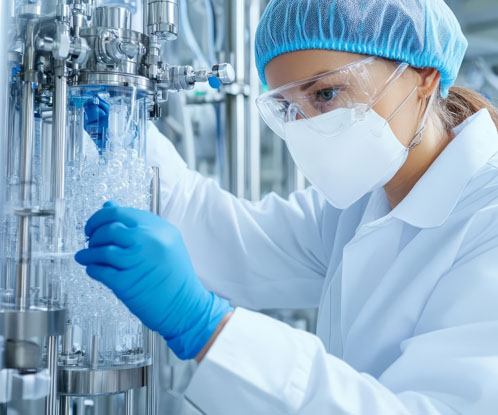As drug pipelines expand to include increasingly complex modalities, technology transfer has emerged as one of the most strategic steps in the biopharmaceutical value chain.
Process transfer for modalities such as multispecific antibodies, fusion proteins, messenger RNA (mRNA)-based biologics and antibody-drug conjugates (ADCs) requires a structured approach that balances precision, speed and reliability to ensure commercial readiness.
The success of these transfers not only determines the manufacturability of advanced therapeutics but also the ability of companies to meet regulatory expectations and patient needs within constrained timelines.
Dr Rinbok Wi (pictured), Lead Scientist, MSAT Downstream Technology Transfer at Samsung Biologics, reports.
The challenge: variability in complex modalities
Unlike monoclonal antibodies, complex modalities present substantial challenges in terms of structure, function and analytical requirements.

ADCs introduce variability because of conjugation chemistry, payload toxicity and specialised buffer conditions that necessitate stringent process adaptation.
Similarly, mRNA-based therapeutics require controlled environments and high-quality raw materials that can withstand contamination and degradation. These technical demands increase uncertainty, complicate scale-up and extend analytical requirements beyond established models.
The regulatory environment further compounds these difficulties by emphasising reproducibility, stability and facility fit.
If transfer frameworks do not adequately address these factors, interruptions may occur during manufacturing that cause unexpected outcomes and delays in regulatory approval.
In a global environment in which timelines are increasingly compressed, variability during technology transfer can create a bottleneck that impacts clinical development and commercial readiness.
The approach: structured and integrated transfer models
To overcome these challenges, contract development and manufacturing organisations (CDMOs) have established structured frameworks that combine modality specific expertise with integrated site capabilities.
The unification of drug substance (DS) and drug product (DP) transfers within the same facility has become critical. It minimises logistical complexity, reduces the regulatory risks associated with inter-site handoffs and consolidates qualification activities that would otherwise extend timelines.
Another essential element is early alignment between stakeholders.
Clearly defined milestones, pre-emptive risk assessment and success criteria provide a stable framework that reduces ambiguity and ensures that all parties share a consistent understanding of project objectives.
This alignment is particularly important in complex modalities when outcomes can differ from predictions and when corrective measures must be implemented within short timeframes.
Digital innovation further enhances predictability within these frameworks. For example, simulation-based tools such as Monte Carlo modelling, multivariate data analysis and computational fluid dynamics are used to validate facility fit, model parameter variability and confirm scalability before GMP execution.
These tools provide quantitative support for decision making, enable predictive risk management and strengthen regulatory preparedness with the early detection of process constraints.
Operational implications: project management and cross-functional execution
Effective technology transfer requires governance structures that extend beyond technical expertise. Dedicated project management organisations ensure continuity by gaining alignment, maintaining communication channels and escalating issues before they affect critical milestones.

A unified project management structure provides a mechanism to consolidate information across the development, manufacturing science and technology (MSAT), quality and supply chain functions, which is essential to sustaining predictable execution.
Operational case studies have demonstrated that concurrent DS and DP execution within a single site accelerates timelines. This consolidation eliminates logistical barriers, shortens material transfer cycles and eliminates duplicate qualification procedures.
Conducting engineering and verification runs early in the transfer process confirms facility fit and prevents risks during GMP campaigns.
Furthermore, continuous collaboration among MSAT, quality and development functions swiftly resolves issues before they affect overall project timelines.
Supply chains are made more resilient with the dual sourcing of raw materials and single-use components, ensuring continuity of supply during scale-up and validation.
Collectively, these measures demonstrate that adherence to structured, integrated and cross-functional models shortens transfer timelines, reinforces compliance and builds confidence during process performance qualification and regulatory inspection readiness.
Key takeaway: technology transfer as a determinant of market readiness
Technology transfer has progressed from being a technical handoff to a determinant of commercialisation success.
The strategic integration of DS and DP execution, combined with the use of digital simulation tools and disciplined project management, enables biopharmaceutical manufacturers to meet market timelines while maintaining compliance and product quality.
Complex modalities impose unique technical and operational demands that cannot be managed with conventional transfer models.
By embedding early alignment, cross-functional collaboration and predictive analytics into structured frameworks, the industry can reduce variability, enhance predictability and ensure supply chain resilience.
As a result, technology transfer is a primary driver of successful development-to-commercial transitions. It not only determines the reliability of manufacturing systems but also the speed with which advanced therapies can reach patients under regulatory oversight.
Bibliography
- https://samsungbiologics.com/media/science-technology/achieving-successful-drug-substance-technology-transfer.
- https://samsungbiologics.com/media/science-technology/accelerated-tech-transfer-with-integrated-client-focused-project-management.
- https://samsungbiologics.com/insights/agile-and-reliable-technology-transfer-for-complex-modalities.
